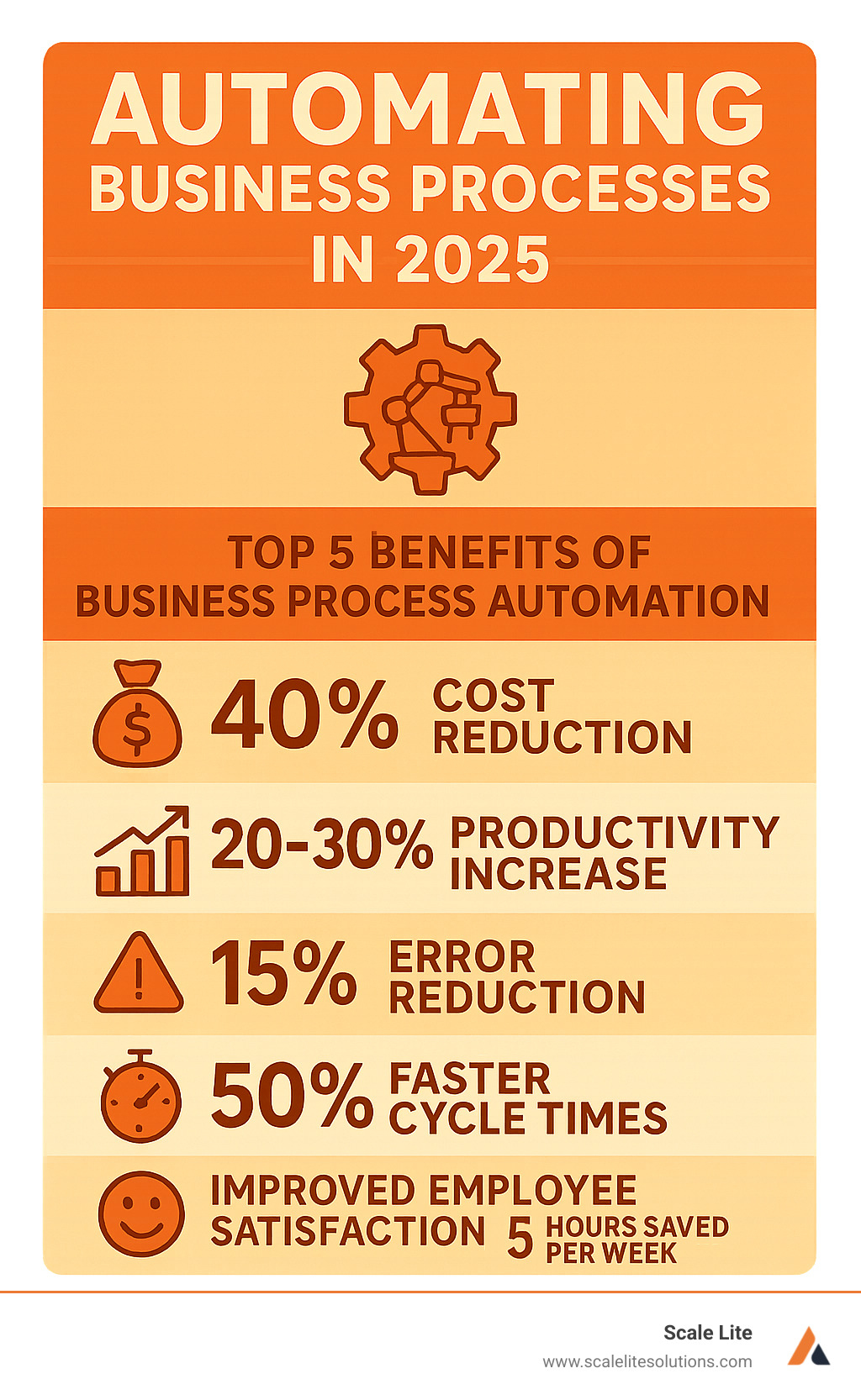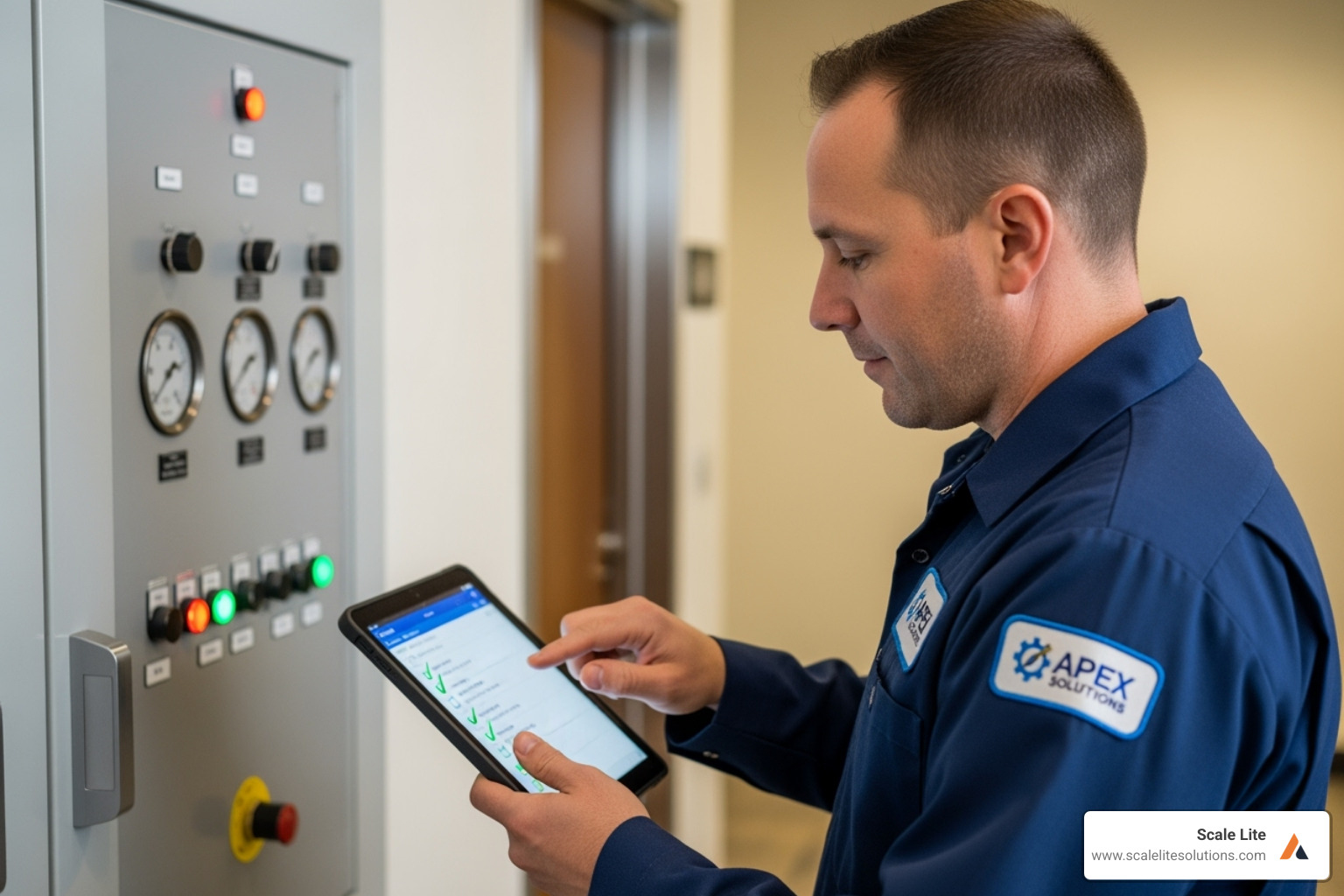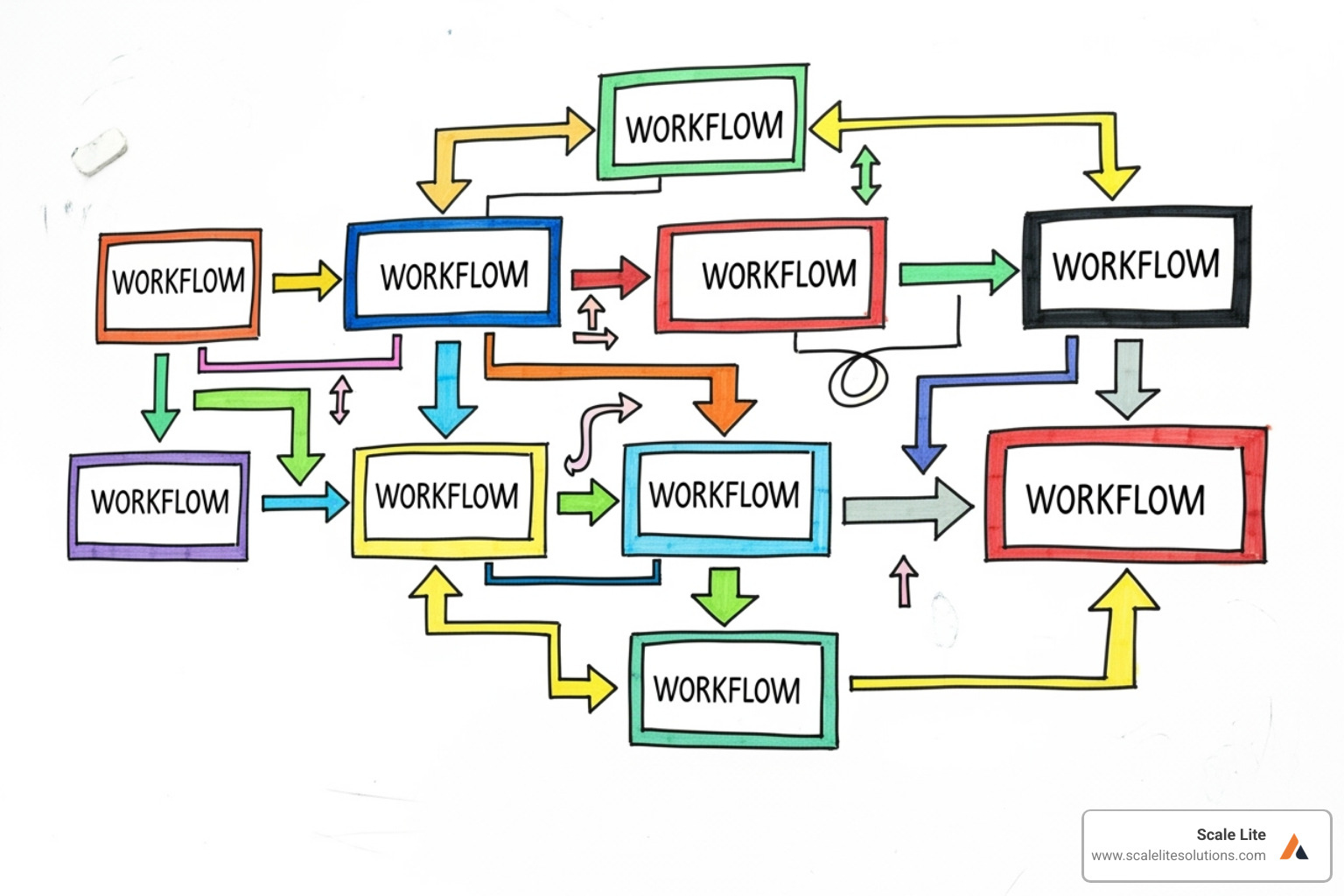
Business Process Automation Made Easy

Why Business Process Automation is Essential for Service Businesses
Automating business processes means using technology to handle repetitive tasks that employees normally do by hand. Instead of manually creating invoices or scheduling appointments, software can do these jobs automatically. It targets repetitive, rule-based, time-consuming, and error-prone tasks, helping service companies run smoother operations while freeing up staff to focus on customers and growth.
The numbers tell a compelling story. Companies that automate processes see 20-30% increases in productivity and can reduce costs by up to 40%. Even better, 86% of companies use automation to improve efficiency, and businesses save an average of 5 hours per week per employee.
Many service business owners are drowning in paperwork and juggling spreadsheets, spending nights on administrative tasks. Your team spends more time on data entry than serving customers. Sound familiar?
The good news is that automation doesn't require a computer science degree or a massive budget. Modern tools are designed for business owners who need results, not complexity.
I'm Keaton Kay. With years of experience from private equity to high-growth firms, I've seen how automating business processes transforms businesses into scalable, valuable companies. My focus is on practical solutions that reduce your workload and prepare your business for growth or sale.

Automating business processes terms to know:
The Core Benefits of Automating Business Processes
Imagine leaving work on time while automated systems handle invoices and payments. This is what happens when service businesses accept automating business processes. The change is more than just saving time; it fundamentally alters how your business operates and grows.
Your Team Becomes Dramatically More Productive
The most immediate change you'll notice is how much more your team accomplishes. Companies that focus on automating business processes see 20-30% increases in productivity—and that's not just doing things faster, it's doing more with the same people.
For example, an invoicing process that takes two hours weekly can be cut to 15 minutes with automation. Those saved hours can be redirected to customer service or business growth.
Your Costs Drop While Your Profits Grow
Here's where automation really shines: automating business processes can reduce costs by up to 40%. Those hidden expenses add up quickly—paper, printing, and the time spent fixing manual errors.
The real savings come from eliminating the inefficiencies that drain your resources. When processes run smoothly without constant supervision, you free up capital for growth instead of firefighting.
Mistakes Become Rare Instead of Routine
We all make mistakes, but when they happen in billing or scheduling, they cost money and damage relationships. Companies implementing automation see a 15% reduction in errors, and the improvement in data accuracy helps you make better business decisions.
Automated systems follow the same rules every single time. Your appointment reminders go out consistently, invoices include all the right details, and customer information stays accurate across all your systems.

Everything Happens Faster
Speed matters in service businesses. Automation can reduce process cycle times by up to 50%, which means faster responses, quicker project completion, and the ability to serve more customers without adding staff.
Your Team Actually Enjoys Their Work More
Perhaps the most important benefit is employee satisfaction. Nobody enjoys spending hours on data entry or paperwork. By automating business processes, you free your employees to focus on the work they actually care about—solving customer problems and growing their skills.
The average employee saves 5 hours per week through automation. As research from the Forbes Coaches Council shows, promoting employee happiness benefits everyone. Happy employees stay longer and contribute more to your success.
Your Customers Notice the Difference
Automation isn't just an internal improvement—your customers feel it too. Intelligent automation can improve customer satisfaction by 25% through faster responses and more consistent communication.
When your systems automatically send appointment confirmations and keep customers informed, you create an experience that feels professional and reliable.
You Sleep Better at Night
For service businesses in regulated industries, compliance isn't optional. Automated processes follow the same rules every time, creating clear audit trails and reducing compliance risks.
The bottom line is simple: automating business processes drives real business results. Companies see up to a 10% increase in revenue alongside all the other benefits. It's not just about efficiency—it's about building a business that can grow sustainably.
This is exactly what we mean by How to Achieve Operational Excellence. When your processes run smoothly, you're building a more valuable, scalable business.
A Practical Guide to Automating Business Processes
Ready to transform your business operations? I've helped dozens of service businesses through this journey, and the key isn't perfection—it's progress. Let's break this down into five manageable steps.
Step 1: Identifying the Right Processes to Automate
Many business owners feel paralyzed by choice, thinking everything needs automation. But it's best to start small. The secret is finding your "low-hanging fruit"—tasks that are repetitive, rule-based, high-volume, and prone to human error.
Start with a simple process analysis. Investigate your own business. Document how tasks get done and where things go wrong. Look for repetition, rule-based tasks, high-volume activities, and error hotspots where mistakes create rework or unhappy customers.
For service businesses, I consistently see success with automating business processes in these areas: invoicing and billing, scheduling and dispatch, customer follow-ups, quoting and estimating, inventory management, and reporting and analytics.
By focusing on these proven winners, you can Streamline Operational Processes and build momentum for bigger projects.
Step 2: Mapping Your Workflow and Setting Goals
This step is like drawing a map before a road trip; you need to know your destination and the best route. Process mapping means creating a visual chart of every step in your chosen process.

This exercise helps you understand your current state, design a future automated state, and create Standard Operating Procedures (SOPs) that define the process, even when automated. Check out our guide on How to Use SOPs for Small Business Digital Change for more details.
Before you touch any software, define what success looks like. Do you want to cut invoicing time by 50% or reduce scheduling errors by 90%? These become your Key Performance Indicators (KPIs) for measuring progress.
Finally, do a simple cost-benefit analysis. Estimate what you're currently spending on the manual process versus what automation will cost and save. This helps justify the investment.
Step 3: Choosing Tools and Implementing Your Automation Strategy
Here's where technology becomes your best friend. Modern automation tools are designed for business owners, not computer programmers.
Technology's role in automating business processes is to execute tasks consistently and connect different systems. Automation types range from simple to complex. Task automation handles single jobs (like an email response), while workflow automation manages a sequence of tasks (like customer onboarding). Process automation covers entire end-to-end business processes, and digital process automation optimizes them for customer experience.
The most exciting development is intelligent automation, which uses Artificial Intelligence. Rule-based automation follows simple "if-then" rules, while intelligent automation uses AI to handle complex scenarios and learn from data, much like a smart assistant compared to a calculator. For deeper insights, explore our guide on AI-Driven Workflow Automation.
When selecting tools, start simple. Focus on integration capabilities with your existing software. Consider scalability, ease of use (no-code or low-code interfaces), and security and compliance.
Step 4: Training Your Team and Managing Change
Implementing automation is more about people than technology. Strategies can fail if the team's reaction to change isn't considered. The biggest challenge is resistance to change, as employees might worry about job security.
Clear communication is everything. Explain that automation makes work better, not eliminates jobs. It frees your team from repetitive tasks to focus on strategic work. Highlight the benefits for staff—show how it makes their jobs easier and more fulfilling, giving them more time for customer interaction and problem-solving.
Provide comprehensive user training with hands-on sessions and resources. Establish clear roles and responsibilities, since automation often shifts how work gets done. Always create a backup plan to temporarily revert to manual processes if needed, which reduces anxiety and ensures business continuity.
Successful automation requires buy-in from everyone. This approach is central to effective Digital Change Strategies for Small Businesses.
Step 5: Measuring the Success of Automating Business Processes
How do you know if your automation is working? Measuring success is an ongoing process of monitoring and fine-tuning.
Evaluating Return on Investment (ROI) goes beyond simple cost savings. Look at total value generated—did you reduce costs, increase revenue, or improve customer satisfaction? Did the time your employees saved translate into more strategic work?
Measure your Key Performance Indicators (KPIs) by revisiting the goals you set in Step 2. Track time savings, cost reduction, error rate decrease, cycle time reduction, employee satisfaction, and customer satisfaction.

Emphasize continuous improvement because automation isn't "set it and forget it." Regularly review your automated processes to find new bottlenecks or opportunities for optimization.
Use data to inform decisions about future automation projects. This data-driven approach forms the foundation of Operational Excellence Strategies and ensures your efforts continue delivering value.
Common Challenges When Automating Business Processes
Automating business processes isn't always smooth sailing. Like a kitchen renovation, the end result is fantastic, but challenges will arise. The good news is that most are manageable if you plan for them.
Initial Costs Can Feel Overwhelming
The biggest hurdle for most service businesses is the upfront investment. Software licenses, integration, and training all add up.
Manual processes have hidden costs, including employee time, materials, and fixing errors. One business owner found they were spending $80 per employee annually on paper alone. The key is conducting a thorough cost-benefit analysis. Start with pilot projects that demonstrate clear value to make future investments easier.
Technical Complexity Doesn't Have to Be Scary
Many business owners worry about integrating new systems with existing software. Start simple with the right tools. Modern no-code and low-code platforms allow business owners to build automations with simple drag-and-drop interfaces, no programming required. For more complex integrations, partnering with experienced professionals can save you headaches.
Data Quality Issues Create Automated Chaos
Automation will expose any data quality problems you have. Inconsistent or incomplete data will be amplified by automated systems, not fixed. The fix involves cleaning up your data before automating by standardizing how information gets entered, removing duplicates, and filling in missing details.
Security Risks Require Attention, Not Avoidance
Automated systems can become targets for cyber threats, but manual processes have vulnerabilities too. Choose platforms with robust security features. Implement strong access controls so only authorized team members can access sensitive information. Regular security audits help identify potential issues before they become problems.
Employee Fear Is Natural and Manageable
Your team might worry that automation will eliminate their jobs. The reality is that automation restructures work, it doesn't eliminate it. For example, automating invoices frees your office manager to focus on customer relationships and strategic projects. Clear communication from day one makes all the difference. Explain how automation will make their jobs more interesting and support business growth, which creates more opportunities for everyone.
Rigid Systems Can Hurt Flexibility
Some automated systems are so rigid that adapting to changing business needs becomes difficult. Choose modular, configurable solutions that can adapt as your business evolves. Build in human override points. Automation should support your processes, not control them.
Implementation Challenges Are Part of the Journey
Even well-planned projects can face unexpected problems. Manage these challenges by breaking projects into smaller phases. Start with one area, like appointment scheduling. Test thoroughly and involve end-users early, as their feedback is invaluable for catching real-world issues.
Successful automation projects acknowledge these challenges upfront. With proper planning and communication, these challenges become manageable steps. For comprehensive support, consider our Digital Change Services.
Frequently Asked Questions
We've covered a lot of ground on automating business processes, but you probably still have some specific questions. Let's tackle the ones we hear most often.
How does Business Process Automation (BPA) differ from Robotic Process Automation (RPA)?
These terms are often used interchangeably, but they have meaningful differences. Think of it this way: BPA is like redesigning your entire kitchen for maximum efficiency, while RPA is like having a robot that just chops vegetables.
BPA takes a big-picture approach, redesigning and automating entire end-to-end processes, like customer onboarding. It connects multiple systems and often involves human decision points and deep software integration. As the experts at SAP explain, BPA is "a strategy that uses software to automate complex and repetitive business processes." It's about fundamentally changing how work flows through your organization.
RPA focuses on automating specific, repetitive tasks by mimicking human actions on a computer. Bots click, type, and copy data, making them ideal for routine, high-volume tasks that don't require complex thought. Amit Kothari, CEO of Tallyfy, points out that RPA is projected to have a massive economic impact and is a key trend in automation.
You don't have to choose one or the other. A smart automating business processes strategy might use RPA bots for specific tasks within a larger BPA workflow.
What are the first steps for a small business to start with automation?
For a small service business, automating business processes can feel daunting. The secret is you don't need to automate everything at once.
Start with one small, repetitive task that is a consistent pain point, like sending appointment reminders or generating monthly reports.
Map out exactly how that process works right now. Draw out every step to identify who does what and where things go wrong.
Choose simple tools that don't require a computer science degree. Many no-code or low-code platforms let you build automations by dragging and dropping elements.
Test everything thoroughly before going live. Run a small pilot first to catch problems when the stakes are low.
Measure what happens next. Use data on time savings and error reduction to decide what to automate next. This step-by-step approach builds confidence without overwhelming your team or budget.
Can automation really eliminate jobs?
This is a common and understandable fear, but the reality is more positive than the headlines suggest. Automation is about restructuring work, not eliminating people.
Automation frees your team from tedious busy work, allowing them to focus on tasks that require human skills like problem-solving and customer relations. Your team gets to do more meaningful work—solving complex customer problems, building relationships, and helping grow the business. These activities make work satisfying and directly impact your bottom line.
Employees often become automation champions once they see how it improves their daily experience. They're no longer drowning in paperwork; they're using their brains for strategic thinking.
As the Forbes Coaches Council notes in their research on promoting employee happiness benefits everyone, happy employees are more productive and more likely to stick around. Growing businesses need more people, not fewer—they just need people doing higher-value work.
Conclusion: Take the Next Step in Your Automation Journey
We've covered what automating business processes means and how to implement it. The evidence is clear: automation leads to 20-30% productivity increases, 40% cost reductions, and saves employees 5 hours per week.
But here's what I want you to remember most – automation isn't about replacing the human touch that makes your service business special. It's about amplifying it.
Automating tasks like invoicing or scheduling doesn't just save time and reduce errors; it frees your team to focus on customer conversations and problem-solving.
For service businesses in traditional industries, this change might feel like a big leap. But automating business processes today is designed for people exactly like you. The tools are simpler, the costs are lower, and the results are faster than ever before.
At Scale Lite Solutions, our approach isn't about overwhelming you with technology – it's about finding the right tools that fit your specific needs. We help blue-collar service businesses and companies in low-tech industries find which processes will give them the biggest bang for their buck.
The future belongs to businesses that make technology work for their people. Automating business processes isn't just about efficiency – it's about building a business that can grow, scale, and become more valuable, whether you're planning to expand or preparing for a sale.
Your automation journey can begin with one simple process. The key is taking that first step.
Ready to see how automation can transform your operations? Let's explore what's possible for your business.






